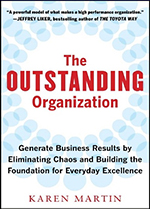Karen Martin’s The Outstanding Organization (McGraw-Hill, 2012) is a 2013 winner of the Shingo Research and Professional Publication Award.
Martin provides well-researched, practical advice on how to become aware of the self-inflicted chaos within your organization that cracks the foundation for outstanding performance. This chaos is due to a lack of:
• Clarity
• Focus
• Discipline
• Engagement
Martin’s conversational tone makes it easy to reflect upon your own performance as well, and she thoroughly explains how the plan-do-study-act (PDSA) improvement methodology applies to individual performance excellence.
 |
In six easy-to-read chapters, you learn how to instill behaviors into your organization that foster:
• Clear communication
• Prioritization
• Effective problem solving
• Creating a rewarding work environment
…
Add new comment